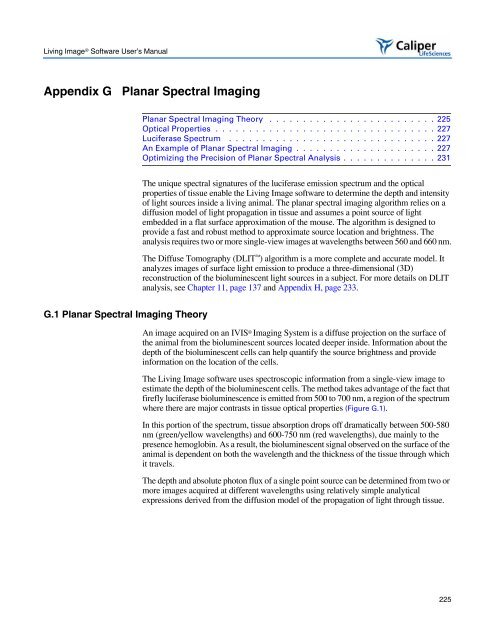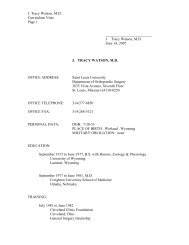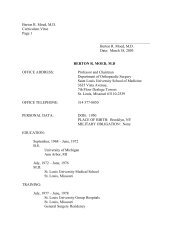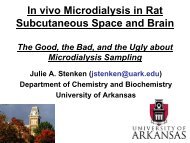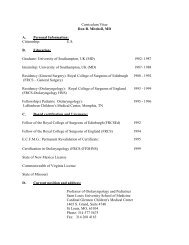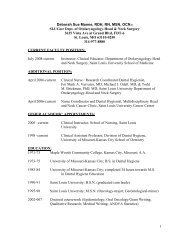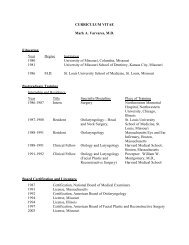Living Image 3.1
Living Image 3.1
Living Image 3.1
You also want an ePaper? Increase the reach of your titles
YUMPU automatically turns print PDFs into web optimized ePapers that Google loves.
<strong>Living</strong> <strong>Image</strong> ® Software User’s Manual<br />
Appendix G Planar Spectral Imaging<br />
G.1 Planar Spectral Imaging Theory<br />
Planar Spectral Imaging Theory . . . . . . . . . . . . . . . . . . . . . . . . . 225<br />
Optical Properties . . . . . . . . . . . . . . . . . . . . . . . . . . . . . . . . . 227<br />
Luciferase Spectrum . . . . . . . . . . . . . . . . . . . . . . . . . . . . . . . 227<br />
An Example of Planar Spectral Imaging . . . . . . . . . . . . . . . . . . . . . 227<br />
Optimizing the Precision of Planar Spectral Analysis . . . . . . . . . . . . . . 231<br />
The unique spectral signatures of the luciferase emission spectrum and the optical<br />
properties of tissue enable the <strong>Living</strong> <strong>Image</strong> software to determine the depth and intensity<br />
of light sources inside a living animal. The planar spectral imaging algorithm relies on a<br />
diffusion model of light propagation in tissue and assumes a point source of light<br />
embedded in a flat surface approximation of the mouse. The algorithm is designed to<br />
provide a fast and robust method to approximate source location and brightness. The<br />
analysis requires two or more single-view images at wavelengths between 560 and 660 nm.<br />
The Diffuse Tomography (DLIT ) algorithm is a more complete and accurate model. It<br />
analyzes images of surface light emission to produce a three-dimensional (3D)<br />
reconstruction of the bioluminescent light sources in a subject. For more details on DLIT<br />
analysis, see Chapter 11, page 137 and Appendix H, page 233.<br />
An image acquired on an IVIS ® Imaging System is a diffuse projection on the surface of<br />
the animal from the bioluminescent sources located deeper inside. Information about the<br />
depth of the bioluminescent cells can help quantify the source brightness and provide<br />
information on the location of the cells.<br />
The <strong>Living</strong> <strong>Image</strong> software uses spectroscopic information from a single-view image to<br />
estimate the depth of the bioluminescent cells. The method takes advantage of the fact that<br />
firefly luciferase bioluminescence is emitted from 500 to 700 nm, a region of the spectrum<br />
where there are major contrasts in tissue optical properties (Figure G.1).<br />
In this portion of the spectrum, tissue absorption drops off dramatically between 500-580<br />
nm (green/yellow wavelengths) and 600-750 nm (red wavelengths), due mainly to the<br />
presence hemoglobin. As a result, the bioluminescent signal observed on the surface of the<br />
animal is dependent on both the wavelength and the thickness of the tissue through which<br />
it travels.<br />
The depth and absolute photon flux of a single point source can be determined from two or<br />
more images acquired at different wavelengths using relatively simple analytical<br />
expressions derived from the diffusion model of the propagation of light through tissue.<br />
225


